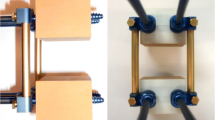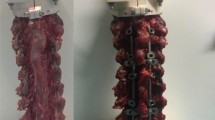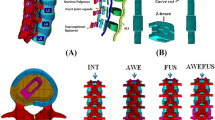Abstract
Posterior instrumentation of the occipito-cervical spine has become an established procedure in a variety of indications. The use of rod-screw systems improved posterior instrumentation as it allows optimal screw positioning adapted to the individual anatomic situation. However, there are still some drawbacks concerning the different implant designs. Therefore, a new modular rod-screw implant system has been developed to overcome some of the drawbacks of established systems. The aim of this study was to evaluate whether posterior internal fixation of the occipito-cervical spine with the new implant system improves primary biomechanical stability. Three different internal fixation systems were compared in this study: the CerviFix System, the Olerud Cervical Rod Spinal System and the newly developed Neon Occipito Cervical System. Eight human cervical spine C0/C5 specimens were instrumented from C0 to C4 with occipital fixation, transarticular screws in C1/C2 and lateral mass or pedicle screws in C3 and C4. The specimens were tested in flexion/extension, axial rotation, and lateral bending using pure moments of ± 2.5 Nm without axial preload. After testing the intact spine, the different instrumentations were tested after destabilising C0/C2 and C3/C4. Primary stability was significantly increased, in all load cases, with the new modular implant system compared to the other implant systems. Pedicle screw instrumentation tended to be more stable compared to lateral mass screws; nevertheless, significant differences were observed only for lateral bending. As the experimental design precluded any cyclic testing, the data represent only the primary stability of the implants. In summary, this study showed that posterior instrumentation of the cervical spine using the new Neon Occipito Cervical System improves primary biomechanical stability compared to the CerviFix System and the Olerud Cervical Rod Spinal System.
Similar content being viewed by others
Author information
Authors and Affiliations
Additional information
Received: 31 December 1999/Revised: 4 April 2000/Accepted: 28 April 2000
Rights and permissions
About this article
Cite this article
Richter, M., Wilke, HJ., Kluger, P. et al. Biomechanical evaluation of a new modular rod-screw implant system for posterior instrumentation of the occipito-cervical spine: in-vitro comparison with two established implant systems. E Spine J 9, 417–425 (2000). https://doi.org/10.1007/s005860000173
Issue Date:
DOI: https://doi.org/10.1007/s005860000173




